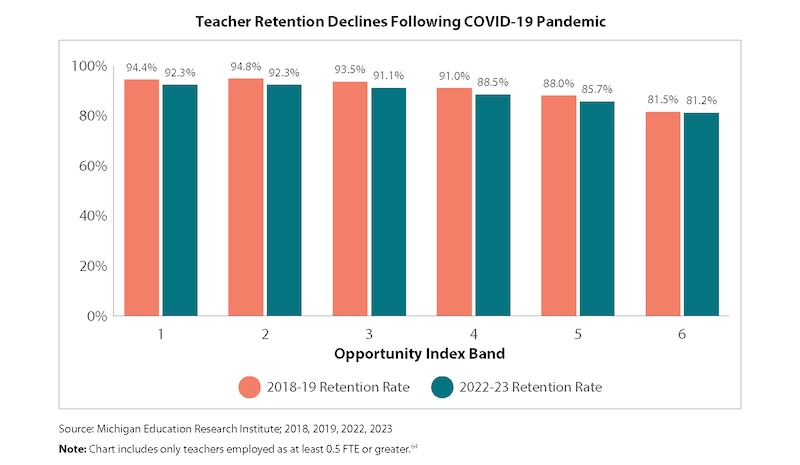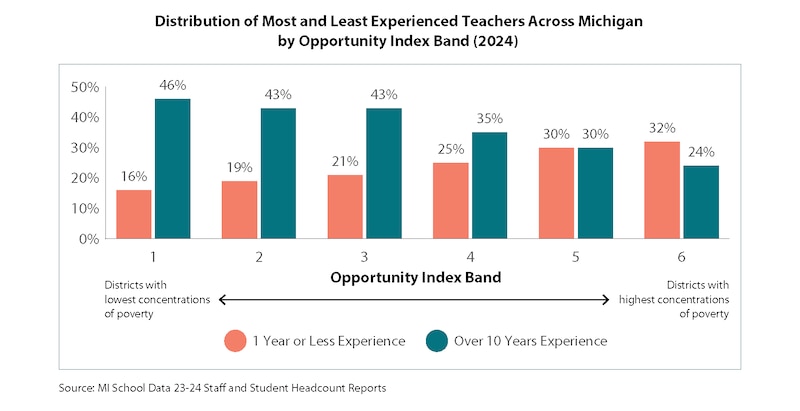Join Chalkbeat Detroit’s free e-newsletter to maintain up with the town’s public college system and Michigan schooling coverage.
Black kids and college students attending faculties in Michigan’s poorest communities usually tend to be taught by much less skilled academics, in keeping with a research that explored the numerous ways in which ongoing instructor shortages have an effect on the state’s most weak college students.
An evaluation launched Tuesday by the nonpartisan analysis and advocacy nonprofit Training Belief-Midwest discovered that college students in these teams usually tend to be taught by academics with emergency credentials and educators instructing outdoors of their fields of research. The districts with the best concentrations of poverty within the state additionally wrestle considerably greater than wealthier college programs to draw and retain skilled academics, the report says.
The evaluation supplies a extra nuanced image of the instructor scarcity that has affected districts all around the state for the reason that COVID pandemic. It exhibits that “everybody actually shouldn’t be struggling equally,” mentioned Jen DeNeal, director of coverage and analysis at Ed Belief-Midwest.

The researchers targeted on inequities within the distribution of extremely certified academics, as a result of years of analysis exhibits that educators’ influence will be extra highly effective than every other consider faculties in figuring out pupil achievement.
“Trainer shortages make up one essential element of alternative gaps that then flip into achievement gaps,” DeNeal mentioned. “And we all know that these gaps end in discrepancies in studying and math proficiency based mostly on elements like race and socioeconomic standing.”
Along with pupil racial demographics, the evaluation makes use of the state’s six alternative index “bands” to research instructor distribution. Districts are assigned to one of many six bands based mostly on the proportion of scholars from economically deprived households, and obtain corresponding dietary supplements to their funding.
The report additionally included enter from focus teams of academics from throughout the state.
What did the evaluation discover?
- Within the state’s highest-poverty districts, greater than 16.5% of academics taught outdoors their very own area of research within the 2022-23 college yr. That was greater than double the state common.
- Districts in probably the most impoverished communities have been 16 instances extra more likely to have academics with emergency credentials — that means people who find themselves both substitute academics or are working towards getting their instructing license.
- First-year academics made up 32% of all instructing workers within the faculties within the state’s highest-poverty communities, in contrast with 16% in wealthier districts. In high-poverty districts, 24% of academics had greater than 10 years of expertise, in contrast with 46% of academics in wealthier districts.
- College programs serving majority Black pupil populations have been almost 4 instances extra more likely to study from educators instructing outdoors of their fields of research than college students in primarily white districts. These college students have been additionally almost twice as more likely to study from a instructor with fewer years’ expertise, and 4 instances extra more likely to study from a instructor with emergency credentials.
- Whereas all districts had a more durable time retaining academics in recent times in contrast with earlier than COVID, retention charges in additional impoverished districts have been 11 proportion factors decrease than within the wealthiest districts in 2022-23.

What does the report recommend to enhance instructor fairness?
The researchers credited Michigan with making “important efforts and investments” to handle the issue by means of revolutionary packages just like the MI Future Educator Fellowship and the MI Future Educator Stipend, together with mentoring and induction packages, and a state funded student-loan reimbursement program.”
Latest efforts additionally embrace permitting some districts to make use of some funds devoted to at-risk college students to draw and retain academics.
In the meantime, low instructor salaries stay an enormous problem for city districts to compete for expertise.
“Why would you go and spend $50,000 to $80,000 to go in pupil mortgage debt to turn into a instructor if you qualify for the Bridge Card?” one instructor mentioned in a spotlight group for the evaluation, referring to eligibility for Michigan’s food-stamp program.
The report recommends that the state deal with this want by making college funding extra equitable.
“Most city public faculties do not need the funds to extend pay instantly,” Kyle Lim of the Grand Rapids-based racial justice group City Core Collective, mentioned in a press release. “As a state, we have to strain our legislators to extend schooling income for faculties.”
Michigan legislators handed a historic price range in 2023 that benefited college students in probably the most want. Advocates, together with Ed Belief-Midwest, mentioned on the time that any such enhance in funding must proceed for many years to make actual change.
Within the 2024-25 college price range, per-pupil funding didn’t enhance, however the state did enhance the chance index funds.
With Republicans now in charge of the state Home and extra friction within the legislature, it’s unclear whether or not future state college budgets will embrace the identical priorities.
DeNeal mentioned there are “constructive indicators” either side of the aisle will assist extra will increase in funding for at-risk college students, citing bipartisan assist final yr for laws to require the “science of studying” in early literacy studying.
The chance index “has widespread advantages for each geographic space, and, frankly, each legislative district within the state of Michigan,” she mentioned.
The report additionally recommends bettering information assortment to raised perceive why academics are leaving the sector; investing and prioritizing assist for directors; and rising entry to high-quality skilled growth.
Maegan Frierson, director of system constructing on the Kent County schooling community Okay-Join, mentioned the instructor scarcity isn’t one thing faculties can “rent their manner out of.”
“If we’re wanting people who could have the best influence on our youngsters, we’ve to have supportive environments,” she mentioned.
The West Michigan Trainer Collaborative, for instance, sees success with periods that join future educators with present academics, Frierson mentioned.
“They’re having conversations with specialists from the neighborhood and getting recommendation from main educators,” she mentioned.
Hannah Dellinger covers Okay-12 schooling and state schooling coverage for Chalkbeat Detroit. You’ll be able to attain her at hdellinger@chalkbeat.org.

